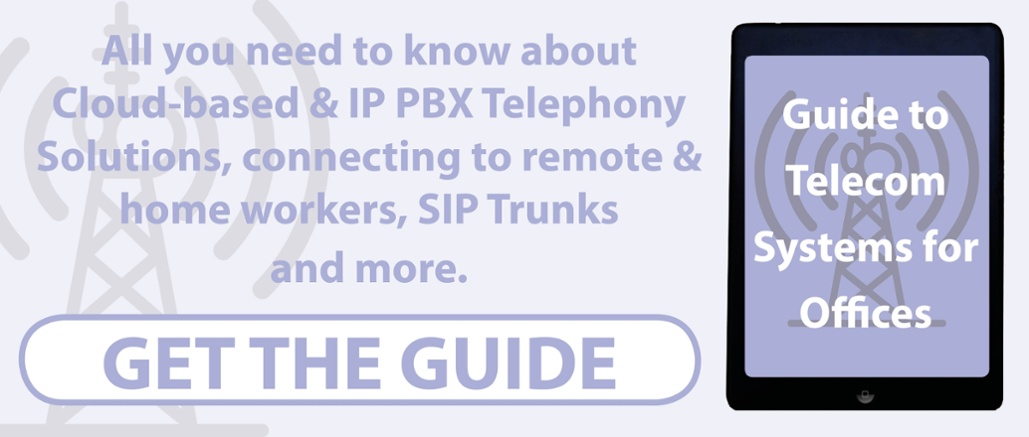
If you are operating an old phone system in your business, then you could be missing out on many of the advantages that new telephony services can offer both employees and customers.
A modern business telephony system is so much more than a group of extensions that share access to external lines. In the past, private branch exchanges (PBXs) tended to be installed by companies because of economy. Essentially, this meant that internal calls could be made without any access to the public switching telephone network (PSTN) and, therefore, no call charges would be incurred. In addition, the number of lines a business rented from the PSTN operator could be reduced. This meant that twelve or sixteen extensions could share, for example, six lines. This usually meant callers would not obtain engaged signals, unless 6 or more extensions were on external calls at the same time, but the expenditure on line rental was reduced.

It is surprising just how many business in the south east of England and the southern part of the Midlands still operate with a telephony system that functions on this sort of model. Older style PBXs still work with a combination of telephone extensions sharing access to analogue phone or digital lines. These days, the degree of functionality offered by well-designed PBXs exceeds most business owners imaginations. Take a few minutes to discover the sort of functions a modern, full functioning PBX can offer your business and how it will interact with the PSTN in ways that improve your business’ efficiency. Above all, a good PBX can improve your customers’ experience every time they call you. Let’s look at a few examples.
Call Distribution Systems
Some businesses put all their incoming calls through a switchboard operator still. Although this personalises the service you offer, it can put operators under pressure at busy times, especially when they are struggling to find the person they are trying to transfer a call through to. Most operators can handle three or four simultaneous callers at once but no more. On the other hand, modern call distribution systems – which are included in the software of a number of PBXs – will allocate calls to extensions which are available to receive them and can even prioritise certain callers, if wanted.
For example, your customer service line could be on a distribution system that rings all of the customer service workers’ phones at the same time. Alternatively, it might pass them calls evenly throughout the day so that the workload is shared. If all of your customer service staff are on the phone, then the distribution system might work in overflow mode, perhaps ringing the sales office if the call is not answered within a time limit. Equally, calls without a rapid response can be passed to an automated attendant system (AA) which will allow callers to either leave a message or continue to hold in a call queue depending on their preference.
Homeworking Telephony Solutions
In modern businesses, not everyone will be expected in the office every day. Many of us work in the field these days and some people are allowed to work at home, for example, to fulfil employers’ commitments to flexible working practices. Older phone systems with limited functionality don’t really facilitate these sorts of modern working practices. However, business phone systems manufacturers have realised that their products must support home workers and people who do their work on site.
A leading PBX manufacturer will provide functions like call control which mean that callers can ring the office number of someone they need to contact within your organisation. If the relevant extension has been correctly configured, then the call can be routed to ring whichever handset the worker is logged into at that time i.e. their office phone, mobile phone or home phone. This means the caller receives a seamless service without needing to keep multiple contact numbers stored for individuals or calling several numbers to reach one person
In addition, software systems mean that when a member of the team is working from home, perhaps on their laptop PC, their availability on the phone can be seen by everyone in the office. These sorts of systems help to integrate the work that people in the office are doing with those at home. For instance, an office worker will be able to tell a caller that their colleague is unavailable to speak to immediately - because they are on the phone – just by looking at their screen even though their teammate might be miles away.
SIP Trunks
Older phone systems tend to work with analogue phone lines, much the same way that domestic phone lines tend to be. Digital lines, on the other hand, provide much more functionality and SIP Trunks even more. A contemporary PBX will be able to handle analogue phone lines, digital phone lines and SIP Trunks or a combination of the three..
In 2025, BT plan to cease their traditional phone network (analogue and digital line services) in favour of providing more functionality to internet based services such as SIP Trunks. Besides being cheaper to install and operate monthly, SIP Trunks are also faster to deploy than ISDN and offer better resiliency with automatic failover. This means that should the trunk lines fail, for whatever reason, calls will automatically ring alternative numbers. Furthermore, it is easy to set up and configure and you don’t have to route all calls to one alternative number like you do with ISDN. With SIP Trunks, it is possible to set alternative destinations on each Direct Dial-In number, which means the caller will still reach the person that they intended to contact, seamlessly.
Call and Email Monitoring
Managing customer enquiries efficiently helps to keep customers happy. Many businesses will have a policy in place to encourage staff to answer all calls within 3 rings to ensure calls aren’t missed and customer enquiries are responded to quickly. Some companies have call logging software that can log all calls and reports can be produced to indicate whether staff are adhering to the 3 ring policy. By measuring the results, it is possible to put alternative measures in place if targets are not met. However, today customers are just as likely to make an enquiry on email; or telephone a sales rep on their mobile phone, as they are to call a business mainline number. The question is; what policies are in place to ensure those enquiries are handled as effectively and what measures can a business implement to monitor?
With a modern telephony solution, it is possible to distribute emails to a team automatically rather than manually. Therefore, rather than a busy service manager dealing with all email enquiries or forwarding them on to his team one at a time, it is possible to automate the process to ensure the workload is spread more evenly throughout the team. Furthermore, monitoring software can identify how long it takes for the team to reply to emails, so measures can be taken to improve the process.




